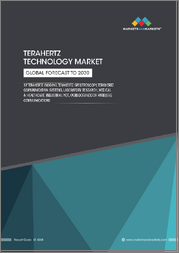
|
시장보고서
상품코드
1636792
테라헤르츠 기술 시장 예측(-2030년) : 유형별, 구성요소별, 용도별, 최종사용자별, 지역별 세계 분석Terahertz Technology Market Forecasts to 2030 - Global Analysis By Type (Terahertz Time Domain Spectroscopy, Terahertz Frequency Domain Spectroscopy, Terahertz Imaging and Other Types), Component, Application, End User and By Geography |
||||||
Stratistics MRC에 따르면, 테라헤르츠 기술 세계 시장은 2024년 6억 7,000만 달러 규모이며, 2030년에는 22억 6,000만 달러에 달할 것으로 예상되며, 예측 기간 동안 21.8%의 CAGR을 기록할 것으로 예측됩니다.
테라헤르츠 기술은 마이크로웨이브와 적외선의 중간에 위치한 0.1-10THz의 테라헤르츠 주파수 대역의 전자파를 이용하는 기술입니다. 테라헤르츠파는 고해상도 이미징, 분광, 통신 등 첨단 애플리케이션을 가능하게 합니다. 테라헤르츠파는 비이온화되어 의복, 포장, 생체 조직 등의 물질을 투과할 수 있어 보안, 의료, 산업 분야에 이상적입니다.
캐나다 통계청(Statistique Canada)에 따르면, 2024년 7월 캐나다의 8개 주요 공항에서 운영 중인 체크포인트에서 탑승 전 보안검색을 통과한 승객은 560만 명으로 2023년 7월 대비 3.3% 증가했다고 밝혔습니다.
비파괴 검사에 대한 수요 증가
테라헤르츠파는 검사 대상물을 손상시키지 않고 고해상도 이미징과 재료 분석을 가능하게 합니다. 항공우주, 자동차, 전자, 제조 등의 산업에서 반도체, 코팅, 복합재료 등 제품의 품질 관리, 안전 검사, 결함 검출을 위해 테라헤르츠 기술을 점점 더 많이 채택하고 있습니다. 재료의 무결성을 손상시키지 않고 제조의 여러 단계에서 검사할 수 있어 효율성을 높이고 비용을 절감하며 제품의 신뢰성을 높일 수 있습니다.
테라헤르츠파 발생 및 검출의 기술적 과제
테라헤르츠파 발생 및 검출의 기술적 과제는 테라헤르츠파의 효율적인 발생 및 검출의 어려움에 기인합니다. 기존의 전자부품은 테라헤르츠 주파수에서 작동하는 데 어려움을 겪고 있으며, 이는 낮은 출력과 제한된 감지 감도로 이어집니다. 또한, 테라헤르츠 주파수를 처리하기 위해서는 특수한 재료와 복잡한 장비가 필요해 비용이 증가합니다. 이러한 문제들은 장치의 성능을 제한하고 제조 비용을 증가시켜 테라헤르츠 기술의 확장성을 저해하고 보급을 방해하고 있습니다.
의료용 이미징 분야로의 적용 확대
테라헤르츠파는 생체 조직을 손상시키지 않고 투과하기 때문에 암, 특히 피부암과 같은 질병을 조기에 발견할 수 있습니다. 또한 조직의 수분 보충, 세포 구조 모니터링, 다양한 장기의 이상 징후를 감지하는 데도 도움이 됩니다. 의료 시스템이 테라헤르츠 기반 진단 도구를 채택함에 따라 이 기술은 영상 진단의 정확도를 높이고 실시간으로 결과를 제공할 수 있습니다. 이러한 비침습적이고 안전하고 정확한 의료 영상 진단 방법에 대한 수요가 증가함에 따라 시장 확대가 가속화되고 의료 분야의 혁신이 촉진될 것입니다.
대안 기술과의 경쟁
X선 이미징, 적외선 분광법, 마이크로파 기반 시스템과 같은 기술은 이미 의료 이미징, 보안, 품질 관리와 같은 산업에 성공적으로 적용되고 있습니다. 이러한 대체 기술들은 유사한 기능을 더 낮은 비용으로, 또는 더 적은 기술적 문제로 제공하는 경우가 많기 때문에 산업계가 새로운 고가의 테라헤르츠 솔루션에 투자할 유인을 떨어뜨리고 있습니다. 이는 테라헤르츠 기술의 채택을 지연시키고 시장 확대를 제한하는 결과를 초래합니다.
COVID-19의 영향
COVID-19 팬데믹은 테라헤르츠 기술 시장에 다양한 영향을 미쳤습니다. 공급망 중단과 실험실 접근 제한으로 인해 연구 개발이 지연된 반면, 의료 및 보안 애플리케이션을 위한 테라헤르츠 이미징과 같은 비침습적 진단 도구에 대한 수요는 증가했습니다. 또한, 팬데믹은 의료 및 안전 분야에서 첨단 기술의 필요성을 부각시켜 향후 시장 성장을 촉진할 수 있습니다. 그러나 경제 불안으로 인해 팬데믹 초기에는 신기술에 대한 투자가 저조했습니다.
예측 기간 동안 재료 특성 평가 분야가 가장 큰 비중을 차지할 것으로 예상됩니다.
재료 특성화 부문은 예측 기간 동안 가장 큰 시장 점유율을 차지할 것으로 예상됩니다. 재료 특성화에서 테라헤르츠 기술은 손상 없이 재료의 특성을 분석하는 데 사용됩니다. 이는 폴리머, 반도체 및 코팅을 포함한 다양한 재료의 구조, 두께, 구성 및 밀도에 대한 귀중한 인사이트를 제공합니다. 과학자들은 테라헤르츠파를 사용하여 전자, 항공우주, 제조 및 기타 산업에서 결함을 감지하고 수분 함량을 측정하며 재료의 품질을 평가할 수 있습니다.
예측 기간 동안 소비자 가전 분야가 가장 높은 CAGR을 기록할 것으로 예상됩니다.
소비자용 전자제품 분야는 예측 기간 동안 가장 높은 CAGR을 보일 것으로 예상됩니다. 테라헤르츠 기술은 디바이스 성능을 향상시키고 혁신적인 기능을 구현할 수 있는 잠재력을 가지고 있어 소비자 전자기기 분야에서 많은 지지를 받고 있습니다. 테라헤르츠는 반도체 및 인쇄회로기판과 같은 전자부품의 품질을 보장하기 위해 제조 시 비파괴 검사에 사용됩니다. 소비자 전자제품의 발전과 함께 테라헤르츠 기술은 부품의 소형화 및 장치 기능 향상에 유망한 애플리케이션을 제공함으로써 업계의 발전을 주도하고 있습니다.
가장 큰 점유율을 차지하는 지역:
아시아태평양은 특히 중국, 일본, 한국 등의 국가에서 연구개발에 대한 투자가 증가함에 따라 예측 기간 동안 가장 큰 시장 점유율을 기록할 것으로 예상됩니다. 이들 국가는 의료 영상, 보안 검사, 통신, 제조 품질 관리 등의 용도로 테라헤르츠 기술을 활용하고 있습니다. 전자, 자동차, 항공우주 등의 산업에서 첨단 통신 시스템 및 비파괴 검사 방법에 대한 수요가 증가하면서 시장 성장을 더욱 촉진하고 있습니다.
CAGR이 가장 높은 지역:
북미는 연구에 대한 활발한 투자, 기술 발전, 헬스케어, 보안, 통신 등 다양한 분야의 수요 증가로 인해 예측 기간 동안 가장 높은 CAGR을 기록할 것으로 예상됩니다. 특히 미국은 의료 영상, 품질 관리, 비파괴 검사 등의 분야에서 이 지역을 선도하고 있습니다. 고속 통신 시스템에 대한 관심 증가와 혁신적인 보안 솔루션에 대한 요구가 시장 확대에 기여하고 있습니다.
무료 커스터마이징 서비스:
본 보고서를 구독하는 고객에게는 다음과 같은 무료 맞춤화 옵션 중 하나를 제공합니다:
- 기업 개요
- 추가 시장 기업의 종합적인 프로파일링(최대 3개사까지)
- 주요 기업 SWOT 분석(3개사까지)
- 지역 세분화
- 고객의 관심에 따른 주요 국가별 시장 추정치, 예측, CAGR(주: 타당성 검토에 따른)
- 경쟁사 벤치마킹
- 제품 포트폴리오, 지리적 입지, 전략적 제휴를 기반으로 한 주요 기업 벤치마킹
목차
제1장 주요 요약
제2장 서문
- 개요
- 이해관계자
- 조사 범위
- 조사 방법
- 데이터 마이닝
- 데이터 분석
- 데이터 검증
- 조사 접근법
- 조사 정보 출처
- 1차 조사 정보 출처
- 2차 조사 정보 출처
- 가정
제3장 시장 동향 분석
- 성장 촉진요인
- 성장 억제요인
- 기회
- 위협
- 용도 분석
- 최종사용자 분석
- 신흥 시장
- COVID-19의 영향
제4장 Porter's Five Forces 분석
- 공급 기업의 교섭력
- 구매자의 교섭력
- 대체품의 위협
- 신규 참여업체의 위협
- 경쟁 기업 간의 경쟁 관계
제5장 세계의 테라헤르츠 기술 시장 : 유형별
- 테라헤르츠 시간 영역 분광법(THz-TDS)
- 테라헤르츠 주파수 영역 분광법(THz-FDS)
- 테라헤르츠 이미징
- 테라헤르츠 방사
- 기타 유형
제6장 세계의 테라헤르츠 기술 시장 : 구성요소별
- 테라헤르츠 소스
- 가스 레이저
- 광전도 안테나
- 양자 캐스케이드 레이저
- 진공관
- 테라헤르츠 검출기
- 볼로미터
- 금속-절연체-금속 다이오드(MIM)
- 포토다이오드
- 테라헤르츠 발생기
- 테라헤르츠 소프트웨어
- 기타 구성요소
제7장 세계의 테라헤르츠 기술 시장 : 용도별
- 재료 특성 평가
- 보안과 감시
- 통신
- 비파괴 검사(NDT)
- 산업 공정 모니터링
- 품질 관리
- 환경 및 대기 모니터링
- 기타 용도
제8장 세계의 테라헤르츠 기술 시장 : 최종사용자별
- 헬스케어
- 항공우주 및 방위
- 가전
- 제조업 및 산업
- 연구개발(R&D)
- 기타 최종사용자
제9장 세계의 테라헤르츠 기술 시장 : 지역별
- 북미
- 미국
- 캐나다
- 멕시코
- 유럽
- 독일
- 영국
- 이탈리아
- 프랑스
- 스페인
- 기타 유럽
- 아시아태평양
- 일본
- 중국
- 인도
- 호주
- 뉴질랜드
- 한국
- 기타 아시아태평양
- 남미
- 아르헨티나
- 브라질
- 칠레
- 기타 남미
- 중동 및 아프리카
- 사우디아라비아
- 아랍에미리트
- 카타르
- 남아프리카공화국
- 기타 중동 및 아프리카
제10장 주요 발전
- 계약, 파트너십, 협업, 합작투자
- 인수와 합병
- 신제품 발매
- 사업 확대
- 기타 주요 전략
제11장 기업 개요
- IBM Corporation
- Thales Group
- NTT Electronics Corporation
- Fujitsu Ltd.
- Stanford Research Systems, Inc.
- Hamamatsu Photonics K.K.
- Optoelectronica
- Lightwave Logic, Inc.
- TeraView Ltd.
- Terasense Group Inc.
- Virginia Diodes, Inc.
- Menlo Systems
- QMC Instruments Ltd.
- Gentec Electro-Optics Inc.
- TicWave Solutions GmbH
- Acal BFi
- NeoPhotonics Corporation
According to Stratistics MRC, the Global Terahertz Technology Market is accounted for $0.67 billion in 2024 and is expected to reach $2.26 billion by 2030 growing at a CAGR of 21.8% during the forecast period. Terahertz technology refers to the use of electromagnetic waves in the terahertz frequency range, typically between 0.1 to 10 THz, which lies between microwave and infrared radiation. It enables advanced applications such as high-resolution imaging, spectroscopy, and communication. Terahertz waves are non-ionizing and can penetrate materials like clothing, packaging, and biological tissues, making them ideal for security, medical, and industrial applications.
According to Statistique Canada, in July 2024, 5.6 million passengers passed through pre-board security screening at checkpoints operated at Canada's eight largest airports, an increase of 3.3% from July 2023.
Market Dynamics:
Driver:
Rising demand for non-destructive testing
Terahertz waves enable high-resolution imaging and material analysis without damaging the object being examined. Industries such as aerospace, automotive, electronics and manufacturing are increasingly adopting terahertz technology for quality control, safety inspections, and defect detection in products like semiconductors, coatings, and composite materials. The ability to inspect materials at various stages of production without compromising their integrity improves efficiency, reduces costs, and enhances product reliability, propelling market growth.
Restraint:
Technical challenges in terahertz wave generation and detection
Technical challenges in terahertz wave generation and detection stem from the difficulty in efficiently producing and detecting terahertz radiation. Traditional electronic components struggle to operate at terahertz frequencies, leading to low power outputs and limited detection sensitivity. Additionally, specialized materials and complex equipment are required to handle terahertz waves, increasing costs. These challenges hamper widespread adoption by limiting device performance and increasing production costs, which hinders the scalability of terahertz technology.
Opportunity:
Growing applications in medical imaging
Terahertz waves can penetrate biological tissues without damaging them, enabling early detection of diseases like cancer, particularly skin cancer. They also help in monitoring tissue hydration, cellular structure, and detecting anomalies in a range of organs. As healthcare systems increasingly adopt terahertz-based diagnostic tools, the technology enhances imaging precision and provides real-time results. This rise in demand for non-invasive, safe, and accurate diagnostic methods in medical imaging accelerates market expansion and fosters innovation within the healthcare sector.
Threat:
Competition from alternative technologies
Technologies such as X-ray imaging, infrared spectroscopy, and microwave-based systems are already well-integrated into industries like medical imaging, security, and quality control. These alternatives often provide similar functionalities at lower costs or with fewer technical challenges, reducing the incentive for industries to invest in new, expensive terahertz solutions. As a result, the adoption of terahertz technology faces delays, limiting its market expansion.
Covid-19 Impact
The covid-19 pandemic had a mixed impact on the terahertz technology market. While research and development slowed due to supply chain disruptions and restricted access to laboratories, the demand for non-invasive diagnostic tools, such as terahertz imaging for medical and security applications, saw a rise. Additionally, the pandemic highlighted the need for advanced technologies in healthcare and safety, potentially boosting future market growth. However, economic uncertainty hindered investments in new technologies during the initial phases of the pandemic.
The material characterization segment is expected to be the largest during the forecast period
The material characterization segment is predicted to secure the largest market share throughout the forecast period. Terahertz technology in material characterization is used to analyze the properties of materials without causing damage. It provides valuable insights into the structure, thickness, composition, and density of various materials, including polymers, semiconductors, and coatings. By using terahertz waves, scientists can detect defects, measure moisture content, and assess material quality in industries such as electronics, aerospace, and manufacturing.
The consumer electronics segment is expected to have the highest CAGR during the forecast period
The consumer electronics segment is anticipated to witness the highest CAGR during the forecast period. Terahertz technology is gaining traction in consumer electronics for its potential in enhancing device performance and enabling innovative features. It is used for non-destructive testing during manufacturing to ensure the quality of electronic components, such as semiconductors and printed circuit boards. As consumer electronics evolve, terahertz technology offers promising applications in miniaturized components and improving device functionality, driving advancements in the industry.
Region with largest share:
Asia Pacific is expected to register the largest market share during the forecast period due to increasing investments in research and development, particularly in countries like China, Japan, and South Korea. These nations are leveraging terahertz technology for applications in medical imaging, security screening, telecommunications, and quality control in manufacturing. The rise in demand for advanced communication systems and non-destructive testing methods in industries such as electronics, automotive and aerospace further drives market growth.
Region with highest CAGR:
North America is expected to witness the highest CAGR over the forecast period driven by robust investments in research, technological advancements, and increasing demand across sectors like healthcare, security, and telecommunications. The United States, in particular, leads the region, with applications in medical imaging, quality control, and non-destructive testing. Growing interest in high-speed communication systems and the need for innovative security solutions further contribute to market expansion.
Key players in the market
Some of the key players profiled in the Terahertz Technology Market include IBM Corporation, Thales Group, NTT Electronics Corporation, Fujitsu Ltd., Stanford Research Systems, Inc., Hamamatsu Photonics K.K., Optoelectronica, Lightwave Logic, Inc., TeraView Ltd., Terasense Group Inc., Virginia Diodes, Inc., Menlo Systems, QMC Instruments Ltd., Gentec Electro-Optics Inc., TicWave Solutions GmbH, Acal BFi and NeoPhotonics Corporation.
Key Developments:
In July 2024, TicWave Solutions GmbH has introduced a new line of silicon-based terahertz products, including cameras, sources, and imaging systems. These products are designed to meet the growing demand for high-performance terahertz technology in both research and industry.
In January 2024, Gentec Electro-Optics unveiled its new PRONTO-250-FLEX Laser Power Meter. This innovative device is designed to measure the power of laser beams across a broad spectrum of wavelengths and power levels. The PRONTO-250-FLEX is designed to measure laser power across a wide range of wavelengths, making it versatile for use in different laser applications.
Types Covered:
- Terahertz Time Domain Spectroscopy (THz-TDS)
- Terahertz Frequency Domain Spectroscopy (THz-FDS)
- Terahertz Imaging
- Terahertz Radiation
- Other Types
Components Covered:
- Terahertz Sources
- Terahertz Detectors
- Terahertz Generators
- Terahertz Software
- Other Components
Applications Covered:
- Material Characterization
- Security & Surveillance
- Communications
- Non-Destructive Testing (NDT)
- Industrial Process Monitoring
- Quality Control
- Environmental & Atmospheric Monitoring
- Other Applications
End Users Covered:
- Healthcare
- Aerospace & Defense
- Consumer Electronics
- Manufacturing & Industrial
- Research & Development (R&D)
- Other End Users
Regions Covered:
- North America
- US
- Canada
- Mexico
- Europe
- Germany
- UK
- Italy
- France
- Spain
- Rest of Europe
- Asia Pacific
- Japan
- China
- India
- Australia
- New Zealand
- South Korea
- Rest of Asia Pacific
- South America
- Argentina
- Brazil
- Chile
- Rest of South America
- Middle East & Africa
- Saudi Arabia
- UAE
- Qatar
- South Africa
- Rest of Middle East & Africa
What our report offers:
- Market share assessments for the regional and country-level segments
- Strategic recommendations for the new entrants
- Covers Market data for the years 2022, 2023, 2024, 2026, and 2030
- Market Trends (Drivers, Constraints, Opportunities, Threats, Challenges, Investment Opportunities, and recommendations)
- Strategic recommendations in key business segments based on the market estimations
- Competitive landscaping mapping the key common trends
- Company profiling with detailed strategies, financials, and recent developments
- Supply chain trends mapping the latest technological advancements
Free Customization Offerings:
All the customers of this report will be entitled to receive one of the following free customization options:
- Company Profiling
- Comprehensive profiling of additional market players (up to 3)
- SWOT Analysis of key players (up to 3)
- Regional Segmentation
- Market estimations, Forecasts and CAGR of any prominent country as per the client's interest (Note: Depends on feasibility check)
- Competitive Benchmarking
- Benchmarking of key players based on product portfolio, geographical presence, and strategic alliances
Table of Contents
1 Executive Summary
2 Preface
- 2.1 Abstract
- 2.2 Stake Holders
- 2.3 Research Scope
- 2.4 Research Methodology
- 2.4.1 Data Mining
- 2.4.2 Data Analysis
- 2.4.3 Data Validation
- 2.4.4 Research Approach
- 2.5 Research Sources
- 2.5.1 Primary Research Sources
- 2.5.2 Secondary Research Sources
- 2.5.3 Assumptions
3 Market Trend Analysis
- 3.1 Introduction
- 3.2 Drivers
- 3.3 Restraints
- 3.4 Opportunities
- 3.5 Threats
- 3.6 Application Analysis
- 3.7 End User Analysis
- 3.8 Emerging Markets
- 3.9 Impact of Covid-19
4 Porters Five Force Analysis
- 4.1 Bargaining power of suppliers
- 4.2 Bargaining power of buyers
- 4.3 Threat of substitutes
- 4.4 Threat of new entrants
- 4.5 Competitive rivalry
5 Global Terahertz Technology Market, By Type
- 5.1 Introduction
- 5.2 Terahertz Time Domain Spectroscopy (THz-TDS)
- 5.3 Terahertz Frequency Domain Spectroscopy (THz-FDS)
- 5.4 Terahertz Imaging
- 5.5 Terahertz Radiation
- 5.6 Other Types
6 Global Terahertz Technology Market, By Component
- 6.1 Introduction
- 6.2 Terahertz Sources
- 6.2.1 Gas Lasers
- 6.2.2 Photoconductive Antennas
- 6.2.3 Quantum Cascade Lasers
- 6.2.4 Vacuum Tubes
- 6.3 Terahertz Detectors
- 6.3.1 Bolometers
- 6.3.2 Metal-Insulator-Metal Diodes (MIM)
- 6.3.3 Photodiodes
- 6.4 Terahertz Generators
- 6.5 Terahertz Software
- 6.6 Other Components
7 Global Terahertz Technology Market, By Application
- 7.1 Introduction
- 7.2 Material Characterization
- 7.3 Security & Surveillance
- 7.4 Communications
- 7.5 Non-Destructive Testing (NDT)
- 7.6 Industrial Process Monitoring
- 7.7 Quality Control
- 7.8 Environmental & Atmospheric Monitoring
- 7.9 Other Applications
8 Global Terahertz Technology Market, By End User
- 8.1 Introduction
- 8.2 Healthcare
- 8.3 Aerospace & Defense
- 8.4 Consumer Electronics
- 8.5 Manufacturing & Industrial
- 8.6 Research & Development (R&D)
- 8.7 Other End Users
9 Global Terahertz Technology Market, By Geography
- 9.1 Introduction
- 9.2 North America
- 9.2.1 US
- 9.2.2 Canada
- 9.2.3 Mexico
- 9.3 Europe
- 9.3.1 Germany
- 9.3.2 UK
- 9.3.3 Italy
- 9.3.4 France
- 9.3.5 Spain
- 9.3.6 Rest of Europe
- 9.4 Asia Pacific
- 9.4.1 Japan
- 9.4.2 China
- 9.4.3 India
- 9.4.4 Australia
- 9.4.5 New Zealand
- 9.4.6 South Korea
- 9.4.7 Rest of Asia Pacific
- 9.5 South America
- 9.5.1 Argentina
- 9.5.2 Brazil
- 9.5.3 Chile
- 9.5.4 Rest of South America
- 9.6 Middle East & Africa
- 9.6.1 Saudi Arabia
- 9.6.2 UAE
- 9.6.3 Qatar
- 9.6.4 South Africa
- 9.6.5 Rest of Middle East & Africa
10 Key Developments
- 10.1 Agreements, Partnerships, Collaborations and Joint Ventures
- 10.2 Acquisitions & Mergers
- 10.3 New Product Launch
- 10.4 Expansions
- 10.5 Other Key Strategies
11 Company Profiling
- 11.1 IBM Corporation
- 11.2 Thales Group
- 11.3 NTT Electronics Corporation
- 11.4 Fujitsu Ltd.
- 11.5 Stanford Research Systems, Inc.
- 11.6 Hamamatsu Photonics K.K.
- 11.7 Optoelectronica
- 11.8 Lightwave Logic, Inc.
- 11.9 TeraView Ltd.
- 11.10 Terasense Group Inc.
- 11.11 Virginia Diodes, Inc.
- 11.12 Menlo Systems
- 11.13 QMC Instruments Ltd.
- 11.14 Gentec Electro-Optics Inc.
- 11.15 TicWave Solutions GmbH
- 11.16 Acal BFi
- 11.17 NeoPhotonics Corporation



















